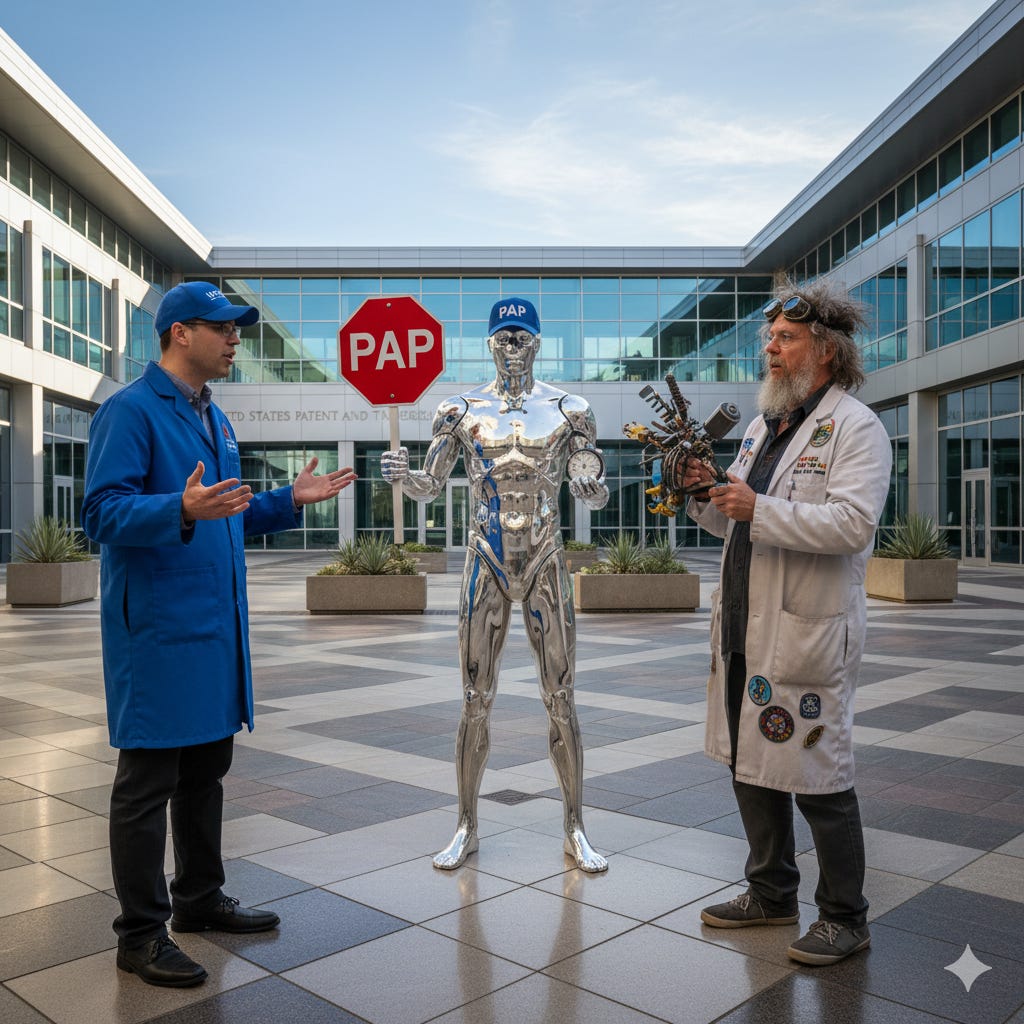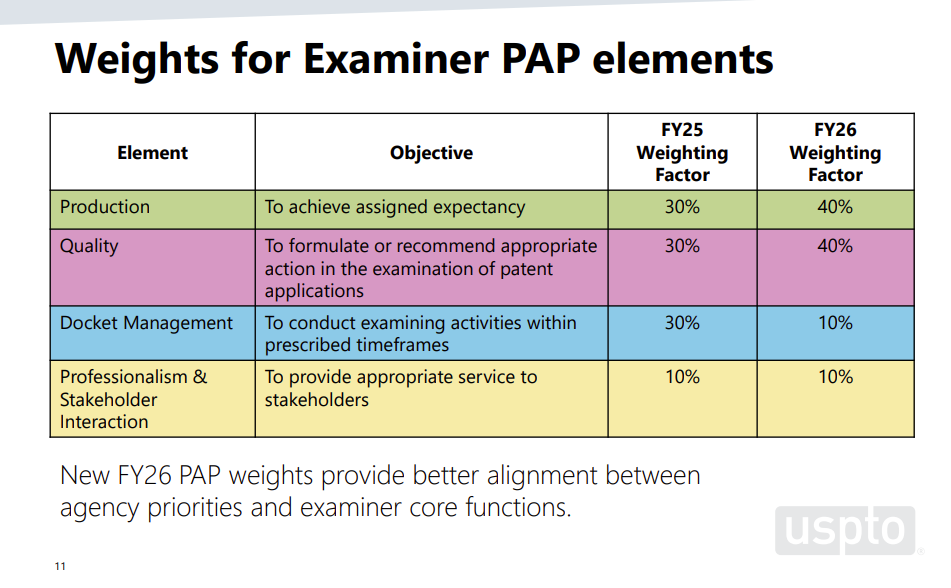USPTO Details New Examiner Performance Plan for FY2026
Rolling out the new PAP
In a recent USPTO Hour presentation, “Understanding a patent examiner’s role in the IP community,” agency leaders detailed the mission of patent examiners and outlined significant changes to their performance metrics for Fiscal Year 2026 (FY26). The discussion, led by Deputy Commissioner for Patents Jerry Lorengo and Supervisory Patent Examiner Joshua Benitez, provided a look into the new Performance Appraisal Plan (PAP) that rebalances the core responsibilities of the examining corps.
Reviewing the USPTO’s slides from the presentation, for patent attorneys and applicants, these internal performance standards are significant, as they directly influence examiner behavior, prosecution timelines, and the focus of examination.
The Role of the Patent Examiner
Mr. Lorengo began by grounding the examiner’s function in its foundational purpose. “The role is high level to serve public interest with respect to intellectual property,” he stated, noting it is one of the few jobs directly mentioned in the Constitution (Lorengo, USPTO Hour).
The examiner’s responsibilities are broken into three phases:
Pre-search activities: Reading and understanding the invention, checking for formal requirements, and determining the scope of the claims (p. 5).
Search: Searching existing technology and selecting relevant prior art (p. 5).
Patentability determination: Writing office actions, responding to applicant replies, and issuing notices of allowance or abandonment (p. 5).
Mr. Lorengo emphasized the human element behind the work. “We never know if the application in front of us is from a single person working on it entire life... Every application counts and there is a person behind every application” (Lorengo, USPTO Hour).
The FY26 PAP: A Rebalance of Priorities
The new FY26 PAP is driven by a focus on “Excellence and accountability” (p. 9). The most substantial change is the re-weighting of the four critical elements of an examiner’s job.
Docket Management, which previously accounted for 30% of an examiner’s rating, has been reduced to 10%. That 20% has been redistributed equally to Production and Quality.
“We believe new PAP weights provide better alignment in priorities and examiner core functions,” Mr. Lorengo explained (Lorengo, USPTO Hour).
A Higher Bar for Production
The new 40% weighting for production is accompanied by higher standards. The “Fully Successful” rating, which previously required 95% performance, will now require 100% (p. 27). “We have moved to a system where we believe that 100% is the right spot for people to achieve a fully successful degree of work,” Mr. Lorengo stated (USPTO Hour).
Other production-related changes include:
Patent Prosecution Highway (PPH): The count value for PPH applications will be reduced from 2.0 to 1.5 (p. 23). The agency justifies this by noting that “First action allowance rates of PPH applications are approximately double compared to non-PPH applications” (p. 23).
Interview Attribute Hours: This time compensation is being adjusted to “1 hour per new application or RCE... when, during prosecution, the examiner conducts an interview” (p. 25). This is a change from the FY25 standard, which was one hour total. The change “promotes interviews as a tool to advance prosecution” (p. 25).
IDS Attribute Hours: The threshold for receiving additional time for reviewing Information Disclosure Statements is changing. In FY25, examiners received one hour for considering “10 or more cumulative pages of IDS.” In FY26, this will be “1 hour... for which the examiner has first considered 50 or more cumulative IDS references” (p. 26). This change aims to “better align with IDS fees” (p. 26).
Increased Scrutiny on Quality
With Quality also weighted at 40%, the USPTO is implementing new review procedures, extending scrutiny to senior and primary examiners.
Under the FY26 plan, Supervisory Patent Examiners (SPEs) will be “required to complete at least four in-depth reviews per examiner, per quarter,” doubling the previous requirement of two (p. 31).
Perhaps more significantly, SPEs will now “complete a streamlined review of all FAOMs [First Actions on the Merits] from all GS-15, GS-14 and GS-13PSA examiners prior to mailing” (p. 31). This streamlined review will evaluate “all independent claims and any dependent claims indicated as allowable” (p. 31).
This marks a new layer of oversight for experienced examiners who previously had full signatory authority.
Docket and Professionalism Adjustments
While its weight is reduced to 10%, Docket Management’s “Fully Successful” performance level is also raised to 100% (p. 39).
The agency is also “evaluating the optimum docket size,” moving from approximately three months of available work to two months, to “help ensure we maintain first in and first out type of approach” (p. 40; Benitez, USPTO Hour).
Professionalism & Stakeholder Interaction (PSI) remains at 10%. The FY25 list of 11 major activities (p. 45) has been consolidated into 7 new major activities for FY26 (p. 46). Mr. Benitez clarified this “is not deemphasizing” the element; “instead what we did was essentially rebucketize 11 activities into 7” (USPTO Hour).
Intended Benefits and New Burdens
Intended Benefits:
The equal 40/40 split for Production and Quality is intended to send a clear message that the agency values both throughput and examination accuracy.
Theoretically, increased SPE review of senior examiners’ first actions could improve the quality and consistency of FAOMs, potentially reducing downstream corrections.
Formally clarifying that interview time is available per RCE (p. 25) supports a practice many practitioners find valuable.
Challenges and Potential New Burdens:
A New Definition of Success: Raising the “Fully Successful” production standard from 95% to 100% (p. 27) is a significant change. Examiners who were previously performing successfully at 95% will now need to increase their output to meet the new baseline, a considerable new expectation.
Uncompensated IDS Review: The change in attribute hours for IDS review—from 10+ pages to 50+ references (p. 26)—is substantial. This places a new, uncompensated time burden on examiners, who are still required to review voluminous IDS filings but will be compensated for that time far less frequently.
Increased Oversight and Workload: The new streamlined review of all senior examiner FAOMs (p. 31), coupled with the doubling of in-depth reviews (p. 31), represents a major procedural shift. This adds a new layer of oversight for the most experienced examiners and places a significant new workload on SPEs, which could introduce delays as supervisors adjust to their own increased responsibilities.
Chilling Effect on Interviews: By saying that “Time for an additional interview may be authorized with SPE approval,” the new PAP indicates that 1 hour is not automatically granted for an interview outside the filing of a new application or an RCE. This could make examiners and representatives hesitant to engage in discussions.
Conclusion
The FY26 PAP represents a clear effort by the USPTO to refine its internal priorities, asking examiners to meet a higher bar for both production and quality.
Patent practitioners—and examiners themselves—will no doubt be watching closely to see how these new standards influence the examining corps.
The new thresholds for IDS and interview time are of immediate practical importance, but the long-term effects of these new production demands and increased quality reviews on pendency and examiner morale remain to be seen.
Disclaimer: This is provided for informational purposes only and does not constitute legal or financial advice. To the extent there are any opinions in this article, they are the author’s alone and do not represent the beliefs of his firm or clients. The strategies expressed are purely speculation based on publicly available information. The information expressed is subject to change at any time and should be checked for completeness, accuracy and current applicability. For advice, consult a suitably licensed attorney and/or patent professional.





